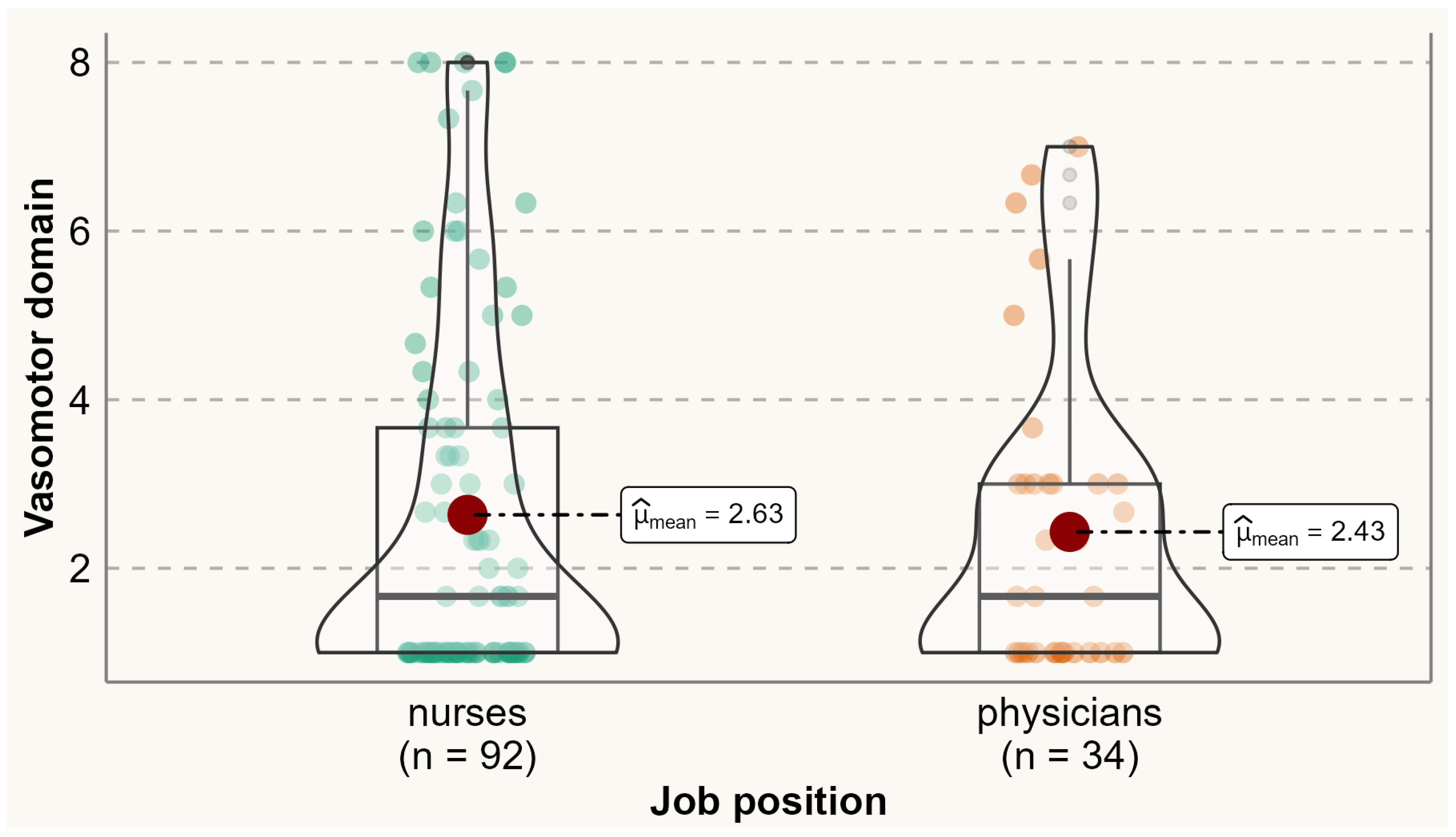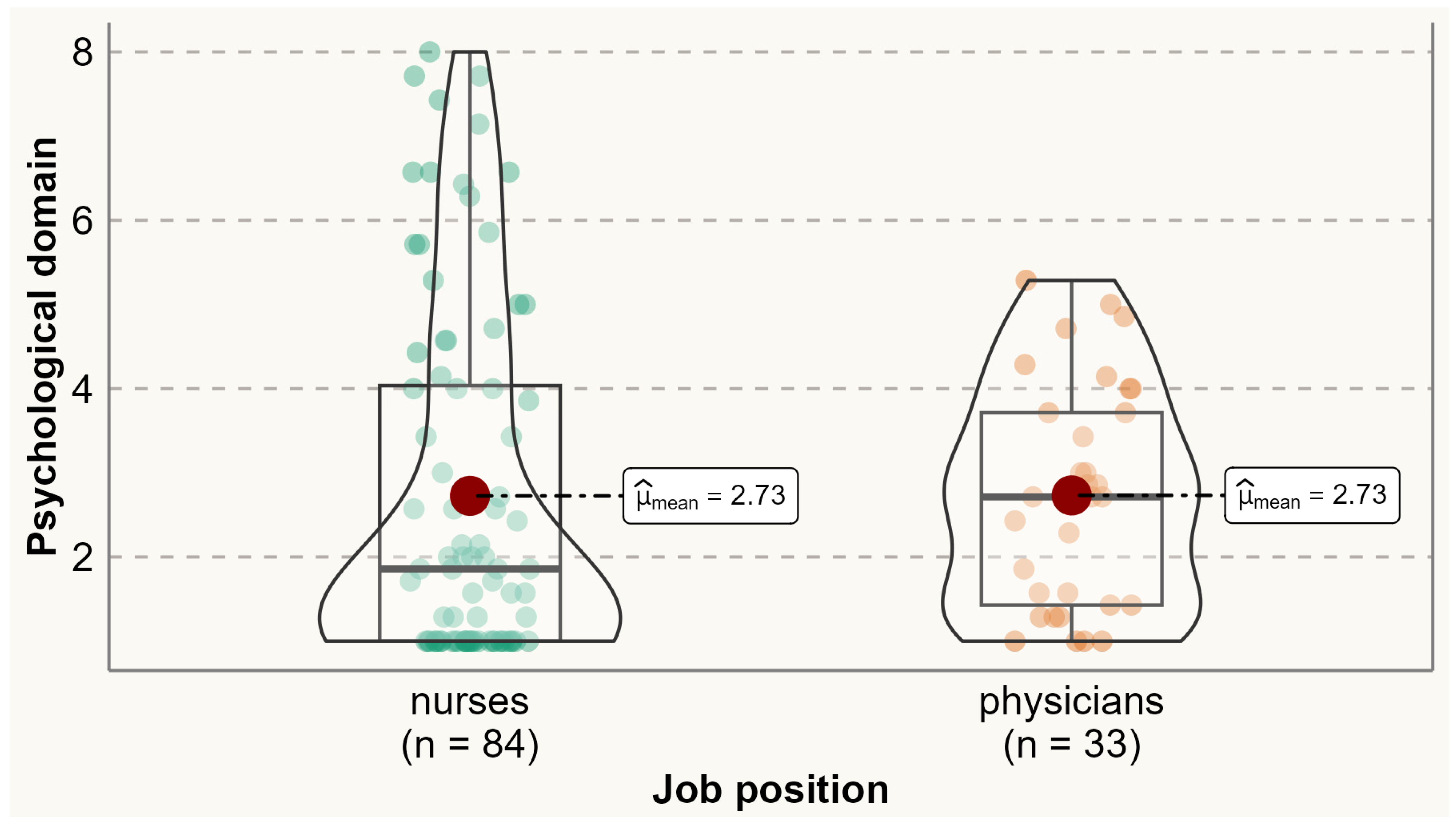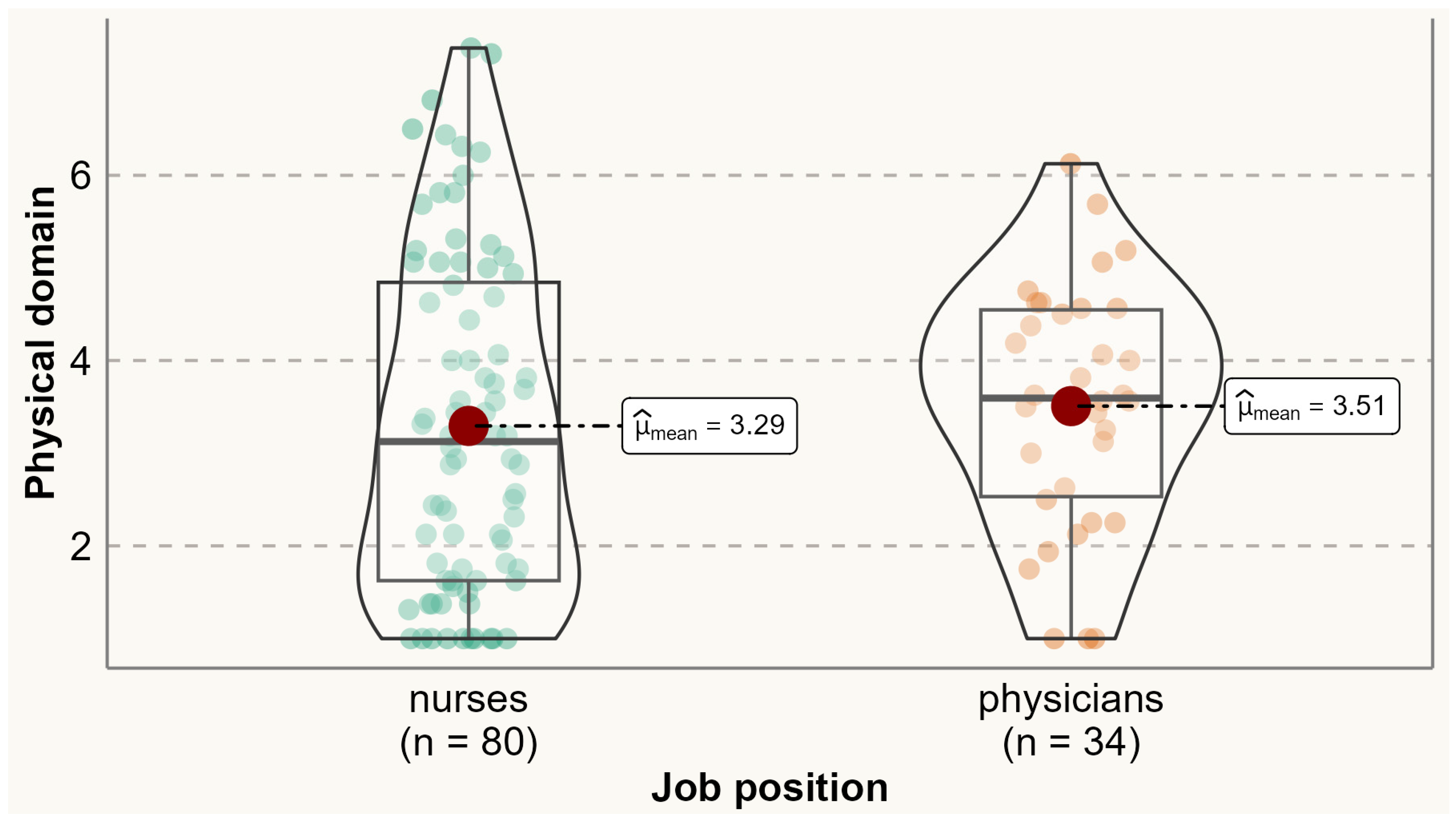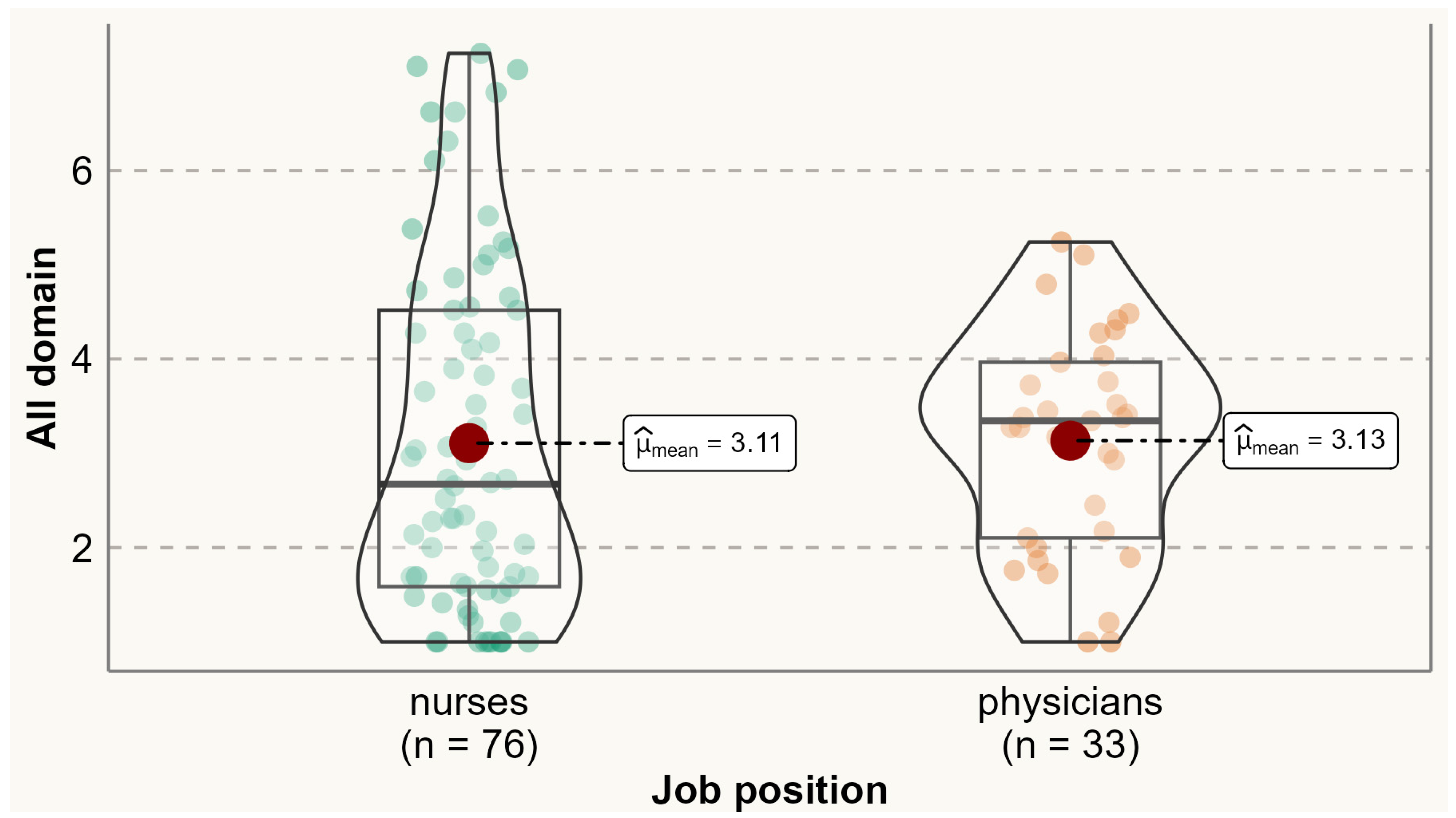Unveiling the Role of the Work Environment in the Quality of Life of Menopausal Physicians and Nurses
Abstract
:1. Introduction
2. Materials and Methods
2.1. Data Collection and Participants
2.2. Study Instrument
2.3. Statistical Analysis
3. Results
4. Discussion
5. Conclusions
Supplementary Materials
Author Contributions
Funding
Institutional Review Board Statement
Informed Consent Statement
Data Availability Statement
Acknowledgments
Conflicts of Interest
References
- Talaulikar, V. Menopause Transition: Physiology and Symptoms. Best Pract. Res. Clin. Obstet. Gynaecol. 2022, 81, 3–7. [Google Scholar] [CrossRef] [PubMed]
- Palacios, S.; Henderson, V.W.; Siseles, N.; Tan, D.; Villaseca, P. Age of Menopause and Impact of Climacteric Symptoms by Geographical Region. Climacteric 2010, 13, 419–428. [Google Scholar] [CrossRef] [PubMed]
- Hill, K. The Demography of Menopause. Maturitas 1996, 23, 113–127. [Google Scholar] [CrossRef] [PubMed]
- Wang, L.R.; Zhang, R.; Yang, Y.; Sun, X.Y.; Zhang, B.L.; Zhu, H.Y.; Luo, X.R.; Ma, X.L.; Zhang, X.H. Severity and Factors of Menopausal Symptoms in Middle-Aged Women in Gansu Province of China: A Cross-Sectional Study. BMC Women’s Health 2021, 21, 405. [Google Scholar] [CrossRef] [PubMed]
- Yim, G.; Ahn, Y.; Chang, Y.; Ryu, S.; Lim, J.Y.; Kang, D.; Choi, E.K.; Ahn, J.; Choi, Y.; Cho, J.; et al. Prevalence and Severity of Menopause Symptoms and Associated Factors across Menopause Status in Korean Women. Menopause 2015, 22, 1108–1116. [Google Scholar] [CrossRef]
- Santoro, N.; Epperson, C.N.; Mathews, S.B. Menopausal Symptoms and Their Management. Endocrinol. Metab. Clin. N. Am. 2015, 44, 497–515. [Google Scholar] [CrossRef]
- Dotlic, J.; Kurtagic, I.; Nurkovic, S.; Kovacevic, N.; Radovanovic, S.; Rancic, B.; Milosevic, B.; Terzic, M.; Gazibara, T. Factors Associated with General and Health-Related Quality of Life in Menopausal Transition among Women from Serbia. Women Health 2018, 58, 278–296. [Google Scholar] [CrossRef]
- Gazibara, T.; Dotlic, J.; Kovacevic, N.; Kurtagic, I.; Nurkovic, S.; Rancic, B.; Radovanovic, S.; Terzic, M. Validation of the Menopause Rating Scale in Serbian Language. Arch. Gynecol. Obstet. 2015, 292, 1379–1386. [Google Scholar] [CrossRef]
- Gazibara, T.; Kovacevic, N.; Nurkovic, S.; Kurtagic, I.; Radovanovic, S.; Rancic, B.; Terzic, M.; Dotlic, J. Menopause-Specific Quality of Life Questionnaire: Factor and Rasch Analytic Approach. Climacteric 2019, 22, 90–96. [Google Scholar] [CrossRef]
- Omirbayeva, B.S.; Baizholova, R.A.; Nurkhaliyeva, D.M. Health Care System in Transition: Some Aspects of Financing. J. Adv. Res. Law Econ. 2017, 8, 1260–1275. [Google Scholar] [CrossRef]
- World Health Organization. The World Health Statistics. 2020. Available online: https://www.who.int/data/gho/publications/world-health-statistics (accessed on 12 August 2023).
- International Trade Administration. Kazakhstan—Country Commercial Guide. Available online: https://www.trade.gov/country-commercial-guides/kazakhstan-healthcare (accessed on 12 August 2023).
- Agency for Statistics and Strategic Planning of the Republic of Kazakhstan. Number of Medical Workers in Kazakhstan. Available online: https://www.gov.kz/memleket/entities/stat?lang=ru (accessed on 12 August 2023).
- D’Angelo, S.; Bevilacqua, G.; Hammond, J.; Zaballa, E.; Dennison, E.M.; Walker-Bone, K. Impact of Menopausal Symptoms on Work: Findings from Women in the Health and Employment after Fifty (HEAF) Study. Int. J. Environ. Res. Public Health 2023, 20, 295. [Google Scholar] [CrossRef] [PubMed]
- Kerasidou, A.; Horn, R. Making Space for Empathy: Supporting Doctors in the Emotional Labour of Clinical Care Ethics in Clinical Practice. BMC Med. Ethics 2016, 17, 8. [Google Scholar] [CrossRef] [PubMed]
- Hilditch, J.R.; Lewis, J.; Peter, A.; Van Maris, B.; Ross, A.; Franssen, E.; Guyatt, G.H.; Norton, P.G.; Dunn, E. A Menopause-Specific Quality of Life Questionnaire: Development and Psychometric Properties. Maturitas 1996, 24, 161–175. [Google Scholar] [CrossRef] [PubMed]
- Kulasingam, S.; Moineddin, R.; Lewis, J.E.; Tierney, M.C. The Validity of the Menopause Specific Quality of Life Questionnaire in Older Women. Maturitas 2008, 60, 239–243. [Google Scholar] [CrossRef] [PubMed]
- Hasan, S.S.; Ahmadi, K.; Santigo, R.; Ahmed, S.I. The Validity of the Menopause-Specific Quality of Life Questionnaire in Women with Type 2 Diabetes. Climacteric 2014, 17, 456–464. [Google Scholar] [CrossRef]
- Ruiz-Fernández, M.D.; Ortega-Galán, Á.M.; Fernández-Sola, C.; Hernández-Padilla, J.M.; Granero-Molina, J.; Ramos-Pichardo, J.D. Occupational Factors Associated with Health-Related Quality of Life in Nursing Professionals: A Multi-Centre Study. Int. J. Environ. Res. Public Health 2020, 17, 982. [Google Scholar] [CrossRef]
- Karmakar, N.; Majumdar, S.; Dasgupta, A.; Das, S. Quality of Life among Menopausal Women: A Community-Based Study in a Rural Area of West Bengal. J. Midlife Health 2017, 8, 21–27. [Google Scholar] [CrossRef]
- Barati, M.; Akbari-heidari, H.; Samadi-yaghin, E.; Jenabi, E.; Jormand, H.; Kamyari, N. The Factors Associated with the Quality of Life among Postmenopausal Women. BMC Women’s Health 2021, 21, 208. [Google Scholar] [CrossRef]
- Mulhall, S.; Andel, R.; Anstey, K.J. Variation in Symptoms of Depression and Anxiety in Midlife Women by Menopausal Status. Maturitas 2018, 108, 7–12. [Google Scholar] [CrossRef]
- Griffiths, A.; MacLennan, S.J.; Hassard, J. Menopause and Work: An Electronic Survey of Employees’ Attitudes in the UK. Maturitas 2013, 76, 155–159. [Google Scholar] [CrossRef]
- Hardy, C.; Thorne, E.; Griffiths, A.; Hunter, M.S. Work Outcomes in Midlife Women: The Impact of Menopause, Work Stress and Working Environment. Women’s Midlife Health 2018, 4, 3. [Google Scholar] [CrossRef] [PubMed]
- Sun, N.; Lv, D.M.; Man, J.; Wang, X.Y.; Cheng, Q.; Fang, H.L.; Fu, Z.; Liu, S.; Wu, Q.H. The Correlation between Quality of Life and Social Support in Female Nurses. J. Clin. Nurs. 2017, 26, 1005–1010. [Google Scholar] [CrossRef] [PubMed]
- Shobeiri, F.; Jenabi, E.; Hazavehei, S.M.M.; Roshanaei, G. Quality of Life in Postmenopausal Women in Iran: A Population-Based Study. J. Menopausal Med. 2016, 22, 31–38. [Google Scholar] [CrossRef]
- Gartoulla, P.; Bell, R.J.; Worsley, R.; Davis, S.R. Menopausal Vasomotor Symptoms Are Associated with Poor Self-Assessed Work Ability. Maturitas 2016, 87, 33–39. [Google Scholar] [CrossRef]
- High, R.V.; Marcellino, P.A. Menopausal Women and the Work Environment. Soc. Behav. Personal. Int. J. 2006, 22, 347–354. [Google Scholar] [CrossRef]
- Matsuzaki, K.; Uemura, H.; Yasui, T. Associations of Menopausal Symptoms with Job-Related Stress Factors in Nurses in Japan. Maturitas 2014, 79, 77–85. [Google Scholar] [CrossRef] [PubMed]
- Membrive, J.M.; Granero-Molina, J.; Salmerón, M.J.S.; Fernández-Sola, C.; López, C.M.R.; Carreñeo, T.P. Quality of Life in Perimenopausal Women Working in the Health and Educational System. Rev. Lat. Am. Enfermagem 2011, 19, 1314–1321. [Google Scholar] [CrossRef]





| Variables | Physicians (N = 35) | Nurses (N = 95) | p-Value |
|---|---|---|---|
| Age | 0.152 | ||
| 40–49 | 12 (34.29%) | 46 (48.42%) | |
| 50–54 | 11 (31.43%) | 31 (32.63%) | |
| 55+ | 12 (34.29%) | 18 (18.95%) | |
| Marital status, N (%) | 0.023 | ||
| Married | 23 (65.71%) | 41 (43.16%) | |
| Other (single, divorced, widowed) | 12 (34.29%) | 54 (56.84%) | |
| Education, N (%) | <0.001 | ||
| Higher education | 29 (82.86%) | 24 (25.26%) | |
| Specialized secondary education | 1 (2.86%) | 68 (71.58%) | |
| Other * | 5 (14.29%) | 3 (3.16%) | |
| Medical organization, N (%) | 0.434 ** | ||
| National Scientific Center for Mother and Child | 13 (39.39%) | 42 (47.19%) | |
| Republican Diagnostic Center | 14 (42.42%) | 36 (40.45%) | |
| Republican Children’s Rehabilitation Center | 4 (12.12%) | 3 (3.37%) | |
| University Health Center | 2 (6.06%) | 7 (7.87%) | |
| Department, N (%) | 0.024 | ||
| Surgical | 4 (12.9%) | 26 (37.68%) | |
| Internal medicine | 18 (58.06%) | 24 (34.78%) | |
| Other (Master’s and Doctorate degrees) | 9 (29.03%) | 19 (27.54%) | |
| Work hours per week, N (%) | 0.054 | ||
| <40 h | 6 (17.14%) | 26 (27.66%) | |
| 40–60 h | 26 (74.29%) | 48 (51.06%) | |
| >60 h | 3 (8.57%) | 20 (21.28%) | |
| Having night shifts, N (%) | <0.001 | ||
| Yes | 6 (17.14%) | 52 (55.32%) | |
| No | 29 (82.86%) | 42 (44.68%) | |
| Having management responsibilities, N (%) | 0.004 | ||
| Yes | 16 (50%) | 21 (22.83%) | |
| No | 16 (50%) | 71 (77.17%) | |
| General satisfaction with job, N (%) | 0.177 | ||
| Satisfied | 26 (76.47%) | 58 (63.74%) | |
| Dissatisfied | 8 (23.53%) | 33 (36.26%) | |
| Satisfaction with salary, N (%) | 0.246 | ||
| Satisfied | 15 (42.86%) | 29 (31.87%) | |
| Dissatisfied | 20 (57.14%) | 62 (68.13%) | |
| Satisfaction with work environment, N (%) | 0.248 | ||
| Satisfied | 25 (71.43%) | 76 (80.85%) | |
| Dissatisfied | 10 (28.57%) | 18 (19.15%) | |
| Self-reported menopause status, N (%) | 0.882 | ||
| Premenopause | 12 (34.29%) | 32 (36.78%) | |
| Perimenopause | 6 (17.14%) | 17 (19.54%) | |
| Postmenopause | 17 (48.57%) | 38 (43.68%) |
| Symptom | Physicians | Nurses | p-Value |
|---|---|---|---|
| Vasomotor Symptoms | |||
| Hot flashes | 42.86% | 41.94% | 0.925 |
| Nights sweats | 38.24% | 34.94% | 0.661 |
| Sweating | 37.14% | 37.23% | 0.992 |
| Psychological symptoms | |||
| Being dissatisfied with their personal life | 47.06% | 32.26% | 0.124 |
| Feeling anxious or nervous | 57.58% | 44.57% | 0.199 |
| Experiencing poor memory | 61.76% | 47.25% | 0.149 |
| Accomplishing less than they used to | 60.00% | 38.20% | 0.028 |
| Feeling depressed, down or blue | 50.00% | 38.20% | 0.235 |
| Being impatient with other people | 58.82% | 44.32% | 0.151 |
| Feelings of wanting to be alone | 51.52% | 39.56% | 0.234 |
| Physical symptoms | |||
| Flatulence or gas pains | 71.43% | 48.39% | 0.02 |
| Aches in the muscles and joints | 64.71% | 53.41% | 0.259 |
| Feeling tired or worn out | 85.29% | 69.41% | 0.075 |
| Difficulty sleeping | 58.82% | 52.22% | 0.55 |
| Aches in the back, neck or head | 73.53% | 59.55% | 0.15 |
| Decrease in physical strength | 77.14% | 60.23% | 0.076 |
| Decrease in stamina | 77.14% | 61.80% | 0.104 |
| Feeling a lack of energy | 79.41% | 61.80% | 0.064 |
| Dry skin | 73.53% | 63.33% | 0.285 |
| Weight gain | 79.41% | 50.00% | 0.003 |
| Increased facial hair | 37.14% | 20.88% | 0.06 |
| Changes in appearance, texture or tone of skin | 79.59% | 50.00% | 0.04 |
| Feeling bloated | 65.71% | 43.96% | 0.029 |
| Low backache | 73.53% | 54.55% | 0.055 |
| Frequent urination | 51.43% | 34.44% | 0.081 |
| Involuntary urination when laughing or coughing | 42.86% | 29.21% | 0.146 |
| Sexual symptoms | |||
| Change in sexual desire | 58.82% | 33.70% | 0.011 |
| Vaginal dryness during intimacy | 37.14% | 31.52% | 0.547 |
| Avoiding intimacy | 45.71% | 49.43% | 0.711 |
| Variables | Vasomotor | Psychological | Physical | Sexual | ||||
|---|---|---|---|---|---|---|---|---|
| Physicians | Nurses | Physicians | Nurses | Physicians | Nurses | Physicians | Nurses | |
| Age | ||||||||
| 40–49 | 1.89 ± 1.66 | 2.24 ± 2.09 | 2.83 ± 1.23 | 2.68 ± 1.98 | 3.5 ± 1.14 | 3.18 ± 1.79 | 2.3 ± 1.64 | 2.46 ± 2.11 |
| 50–54 | 2.39 ± 1.62 | 3.51 ± 2.27 | 3.06 ± 1.38 | 3.02 ± 2.43 | 3.46 ± 1.45 | 3.48 ± 1.97 | 2.97 ± 1.72 | 3.05 ± 2.41 |
| 55+ | 3.06 ± 2.08 | 2.12 ± 1.9 | 2.29 ± 1.34 | 2.36 ± 2.01 | 3.56 ± 1.47 | 3.23 ± 1.61 | 3.08 ± 2.32 | 3.07 ±2.44 |
| p-value | 0.281 * | 0.021 * | 0.274 * | 0.497 * | 0.996 * | 0.811 * | 0.572 * | 0.356 * |
| Marital status, N (%) | ||||||||
| Married | 2.62 ± 1.99 | 2.45 ± 2.28 | 2.66 ± 1.22 | 2.33 ± 2.12 | 3.29 ± 1.38 | 3.23 ± 2.01 | 2.76 ± 1.75 | 2.72 ± 2.35 |
| Other (Single, Divorced, Widowed) | 2.03 ± 1.31 | 2.76 ± 2.12 | 2.87 ± 1.56 | 3.05 ± 2.09 | 3.91 ± 1.15 | 3.34 ± 1.66 | 2.86 ± 2.34 | 2.79 ± 2.21 |
| p-value | 0.619 ** | 0.482 | 0.619 ** | 0.125 | 0.207 ** | 0.785 | 0.912 ** | 0.881 |
| Education, N (%) | ||||||||
| Higher education | 2.56 ± 1.93 | 2.18 ± 1.65 | 2.81 ± 1.38 | 2.21 ± 1.38 | 3.63 ± 1.31 | 2.96 ± 1.58 | 3.06 ± 1.98 | 2.67 ± 1.96 |
| Specialized secondary education | 2.67 ± 0 | 2.82 ± 2.38 | 2.71 ± 0 | 2.92 ± 2.32 | 1.94 ± 0 | 3.49 ± 1.91 | 1 ± 0 | 2.81 ± 2.39 |
| Other * | 1.67 ± 0.94 | 2.33 ± 1.33 | 2.31 ± 1.18 | 3.14 ± 3 | 3.14 ± 1.4 | 2.46 ± 1.34 | 1.67 ± 0.82 | 2.44 ± 2.5 |
| p-value | 0.626 | 0.692 * | 0.69 * | 0.928 | 0.365 * | 0.468 * | 0.251 * | 0.872 * |
| Medical organization, N (%) | ||||||||
| National Scientific Center for Mother and Child | 3.42 ± 2.27 | 2.72 ± 2.25 | 2.85 ± 1.35 | 2.79 ± 2.16 | 3.49 ± 1.21 | 3.47 ± 1.75 | 2.92 ± 2.17 | 2.79 ± 2.25 |
| Republican Diagnostic Center | 2.21 ± 1.39 | 2.47 ± 2.03 | 2.88 ± 1.32 | 2.56 ± 1.98 | 3.63 ± 1.41 | 3.21 ± 1.73 | 3.14 ± 1.79 | 2.69 ± 2.33 |
| Republican Children’s Rehabilitation Center | 1.67 ± 0.94 | 4.11 ± 3.56 | 2.64 ± 1.63 | 3.33 ± 4.04 | 3.97 ± 1.28 | 3.17 ± 3.16 | 2.5 ± 1.75 | 3.44 ± 3.15 |
| University Health Center | 1 ± 0 | 2.38 ± 2.02 | 1.86 ± 1.21 | 3.53 ± 2.35 | 2.59 ± 2.25 | 3.77 ± 2.12 | 1 ± 0 | 2.95 ±2.45 |
| p-value | 0.196 * | 0.798 | 0.702 * | 0.745 * | 0.643 * | 0.85 * | 0.323 * | 0.936 * |
| Department, N (%) | ||||||||
| Surgical | 3 ± 3.46 | 2.55 ± 1.91 | 3.86 ± 0.2 | 3.14 ± 2.28 | 4.29 ± 1.61 | 3.94 ± 1.76 | 3.78 ± 2.83 | 3.04 ± 2.53 |
| Internal Medicine | 2.87 ± 1.94 | 3.49 ± 2.72 | 2.87 ± 1.4 | 3.41 ± 2.49 | 3.51 ± 1.16 | 3.63 ± 2.04 | 2.98 ± 1.92 | 3.43 ± 2.22 |
| Other | 1.93 ± 0.85 | 2.37 ± 1.79 | 2.62 ± 1.31 | 2.47 ± 1.58 | 3.35 ± 1.57 | 2.92 ± 1.47 | 2.33 ± 1.76 | 2.42 ± 2.08 |
| p-value | 0.641 * | 0.193 | 0.508 * | 0.374 | 0.733 * | 0.187 | 0.698 * | 0.369 |
| Work hours per week, N (%) | ||||||||
| <40 h | 1.33 ± 0.56 | 3.68 ± 2.47 | 1.86 ± 1.16 | 2.93 ± 1.98 | 2.27 ± 1.58 | 3.55 ± 1.67 | 2.22 ± 1.71 | 3.15 ± 2.27 |
| 40–60 h | 2.56 ± 1.8 | 2.14 ± 1.82 | 2.96 ± 1.31 | 2.55 ± 2.23 | 3.79 ± 1.13 | 3.18 ± 1.95 | 2.95 ± 1.89 | 2.73 ± 2.24 |
| >60 h | 3.56 ± 2.87 | 2.55 ± 2.27 | 2.67 ± 1.37 | 2.87 ± 2.12 | 3.67 ± 1.34 | 3.18 ± 1.69 | 2.67 ± 2.89 | 2.26 ± 2.32 |
| p-value | 0.216 * | 0.016 | 0.167 * | 0.745 | 0.125 * | 0.703 | 0.583 * | 0.437 |
| Having night shifts, N (%) | ||||||||
| Yes | 2.13 ± 1.76 | 2.61 ± 2.27 | 3.11 ± 1.61 | 2.63 ± 2.04 | 2.95 ± 0.89 | 3.23 ± 1.71 | 3.47 ± 2.82 | 2.64 ± 2.29 |
| No | 2.48 ± 1.84 | 2.71 ± 2.12 | 2.68 ± 1.3 | 2.87 ± 2.23 | 3.6 ± 1.37 | 3.41 ± 1.89 | 2.68 ± 1.74 | 2.93 ± 2.25 |
| p-value | 0.523 ** | 0.829 | 0.525 ** | 0.62 | 0.189 ** | 0.656 | 0.567 ** | 0.567 |
| Have management responsibilities, N (%) | ||||||||
| Yes | 3.35 ± 2.14 | 2.44 ± 1.84 | 3.26 ± 1.28 | 2.79 ± 2.02 | 3.86 ± 1.26 | 3.23 ± 1.88 | 3.39 ± 1.93 | 2.98 ± 2.08 |
| No | 1.69 ± 0.89 | 2.75 ± 2.32 | 2.29 ± 1.19 | 2.73 ± 2.17 | 3.29 ± 1.37 | 3.38 ± 1.79 | 1.83 ± 1.28 | 2.71 ± 2.34 |
| p-value | 0.019 ** | 0.589 | 0.045 ** | 0.913 | 0.309 ** | 0.743 | 0.015 ** | 0.636 |
| General satisfaction with job, N (%) | ||||||||
| Satisfied | 2.67 ± 1.95 | 2.39 ± 2.06 | 2.84 ± 1.27 | 2.23 ± 1.75 | 3.67 ± 1.36 | 2.92 ± 1.57 | 2.95 ± 1.91 | 2.37 ± 2.0 |
| Dissatisfied | 1.76 ± 0.98 | 3.16 ± 2.39 | 2.33 ± 1.52 | 3.69 ± 2.41 | 2.98 ± 1.12 | 4.0 ± 1.97 | 2.29 ± 1.91 | 3.5 ± 2.56 |
| p-value | 0.3 ** | 0.116 | 0.289 ** | 0.002 | 0.161 ** | 0.009 | 0.492 ** | 0.027 |
| Satisfaction with salary, N (%) | ||||||||
| Satisfied | 2.51 ± 1.86 | 2.56 ± 2.09 | 2.66 ± 1.24 | 2.09 ± 1.49 | 3.79 ± 1.56 | 2.65 ± 1.36 | 2.83 ± 1.89 | 2.46 ± 2.16 |
| Dissatisfied | 2.37 ± 1.81 | 2.68 ± 2.25 | 2.78 ± 1.41 | 3.04 ± 2.31 | 3.31 ± 1.13 | 3.61 ± 1.91 | 2.77 ± 1.96 | 2.92 ± 2.32 |
| p-value | 0.799 ** | 0.811 | 0.715 ** | 0.059 | 0.294 ** | 0.033 | 0.943 ** | 0.403 |
| Satisfaction with work environment, N (%) | ||||||||
| Satisfied | 2.68 ± 1.99 | 2.46 ± 2.05 | 2.95 ± 1.27 | 2.44 ± 1.93 | 3.59 ± 1.35 | 3.09 ± 1.71 | 2.97 ± 1.9 | 2.49 ± 2.09 |
| Dissatisfied | 1.74 ± 0.91 | 3.35 ± 2.66 | 2.05 ± 1.33 | 3.87 ± 2.49 | 3.26 ± 1.28 | 4.13 ± 2.06 | 2.29 ± 1.93 | 3.98 ± 2.68 |
| p-value | 0.242 ** | 0.259 ** | 0.064 ** | 0.012 | 0.482 ** | 0.069 | 0.459 ** | 0.071 ** |
| Self-reported menopause status, N (%) | ||||||||
| Premenopause | 2.14 ± 2.08 | 2.02 ± 1.62 | 2.66 ± 1.06 | 2.53 ± 1.93 | 3.53 ± 0.94 | 3.05 ± 1.7 | 2.52 ± 1.67 | 2.09 ± 1.82 |
| Perimenopause | 2.56 ± 1.5 | 3.02 ± 2.22 | 3.31 ± 1.95 | 2.24 ± 1.24 | 3.16 ± 1.72 | 2.8 ± 1.16 | 3 ± 1.98 | 2.25 ± 1.35 |
| Postmenopause | 2.6 ± 1.77 | 3.28 ± 2.52 | 2.56 ± 1.24 | 3.26 ± 2.46 | 3.61 ± 1.44 | 3.88 ± 1.93 | 2.9 ±2.1 | 3.89 ± 2.61 |
| p-value | 0.441 * | 0.066 * | 0.618 * | 0.669 * | 0.966 * | 0.115 * | 0.787 * | 0.012 * |
Disclaimer/Publisher’s Note: The statements, opinions and data contained in all publications are solely those of the individual author(s) and contributor(s) and not of MDPI and/or the editor(s). MDPI and/or the editor(s) disclaim responsibility for any injury to people or property resulting from any ideas, methods, instructions or products referred to in the content. |
© 2023 by the authors. Licensee MDPI, Basel, Switzerland. This article is an open access article distributed under the terms and conditions of the Creative Commons Attribution (CC BY) license (https://creativecommons.org/licenses/by/4.0/).
Share and Cite
Bapayeva, G.; Terzic, M.; Semenova, Y.; Sarria-Santamera, A.; Gusmanov, A.; Aimagambetova, G.; Laganà, A.S.; Chiantera, V.; Kadroldinova, N.; Ukybassova, T.; et al. Unveiling the Role of the Work Environment in the Quality of Life of Menopausal Physicians and Nurses. Int. J. Environ. Res. Public Health 2023, 20, 6744. https://doi.org/10.3390/ijerph20186744
Bapayeva G, Terzic M, Semenova Y, Sarria-Santamera A, Gusmanov A, Aimagambetova G, Laganà AS, Chiantera V, Kadroldinova N, Ukybassova T, et al. Unveiling the Role of the Work Environment in the Quality of Life of Menopausal Physicians and Nurses. International Journal of Environmental Research and Public Health. 2023; 20(18):6744. https://doi.org/10.3390/ijerph20186744
Chicago/Turabian StyleBapayeva, Gauri, Milan Terzic, Yuliya Semenova, Antonio Sarria-Santamera, Arnur Gusmanov, Gulzhanat Aimagambetova, Antonio Simone Laganà, Vito Chiantera, Nazira Kadroldinova, Talshyn Ukybassova, and et al. 2023. "Unveiling the Role of the Work Environment in the Quality of Life of Menopausal Physicians and Nurses" International Journal of Environmental Research and Public Health 20, no. 18: 6744. https://doi.org/10.3390/ijerph20186744
APA StyleBapayeva, G., Terzic, M., Semenova, Y., Sarria-Santamera, A., Gusmanov, A., Aimagambetova, G., Laganà, A. S., Chiantera, V., Kadroldinova, N., Ukybassova, T., Kongrtay, K., Abdukassimova, M., Togyzbayeva, K., & Terzic, S. (2023). Unveiling the Role of the Work Environment in the Quality of Life of Menopausal Physicians and Nurses. International Journal of Environmental Research and Public Health, 20(18), 6744. https://doi.org/10.3390/ijerph20186744









